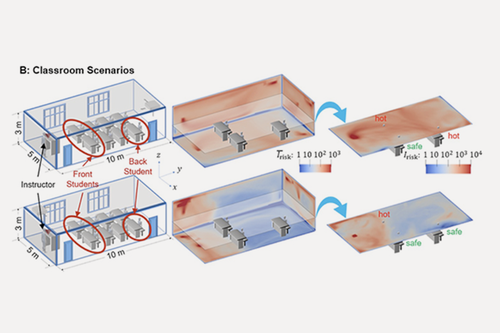
A new study from the University of Minnesota College of Science and Engineering analyzes how the coronavirus spreads indoors—information that could help businesses and schools take precautions to reduce the chance of COVID-19 transmission as they reopen.
Mechanical engineering associate professor Jiarong Hong and assistant professor Suo Yang modeled the airborne virus transmission through aerosols, which are ejected from our mouths when we exhale or speak. The researchers found that when an infected person does this, the SARS CoV-2 virus hitches a ride on those aerosols as they land on nearby surfaces or are inhaled by another person.
{"preview_thumbnail":"/sites/twin-cities.umn.edu/files/styles/video_embed_wysiwyg_preview/public/video_thumbnails/VWrD2zfLOak.jpg?itok=qjrUSjYZ","video_url":"https://youtu.be/VWrD2zfLOak","settings":{"responsive":1,"width":"854","height":"480","autoplay":0},"settings_summary":["Embedded Video (Responsive)."]}
Using aerosol generation from the breathing of eight healthy individuals to mimic that from asymptomatic COVID-19 patients, the researchers were able to numerically model the external flow of the virus through the air in three interior spaces—an elevator, a classroom, and a supermarket. Then, they compared how the virus faired among different levels of ventilation and with different spacing among the rooms’ occupants. The simulations used ventilation systems with inlets and outlets together, side-by-side in the elevator and supermarket cases and on different faces of a box in the classroom case.
“In general, this is the first quantitative risk assessment of the spatial variation of risks in indoor environments,” Hong said. “You see a lot of people talking about what the risks are of staying in confined spaces, but nobody gives a quantitative number. I think the major contribution we’ve made is combining very accurate measurements and computational fluid dynamics simulation to provide a very quantitative estimate of the risks.”
The researchers found that in indoor spaces, good ventilation will filter some of the virus out of the air, but may leave more viral particles on surfaces. In the classroom setting, after running a 50-minute simulation with an asymptomatic teacher consistently talking, the researchers found that only 10 percent of the aerosols were filtered out. The majority of the particles were instead deposited on the walls.
“Because this is very strong ventilation, we thought it would ventilate out a lot of aerosols. But, 10 percent is really a small number,” said Yang, who holds the Richard and Barbara Nelson Assistant Professorship in Mechanical Engineering. “The ventilation forms several circulation zones called vortexes, and the aerosols keep rotating in this vortex. When they collide with the wall, they attach to the wall. But, because they are basically trapped in this vortex, and it’s very hard for them to reach the vent and actually go out.”
In each scenario, the researchers mapped the air flow to find locations of virus “hot” spots, or where the aerosols congregated. With the right combination of ventilation and interior organization, it could be possible to mitigate the disease spread and avoid these hot zones, the researchers said.
For example, in a classroom setting, the virus aerosols spread significantly less throughout the room when the teacher—who is likely doing the most talking—was placed directly under an air vent. This insight could inform how classrooms are arranged and disinfected, and also help places like theaters and concert venues reopen with the proper precautions.
{"preview_thumbnail":"/sites/twin-cities.umn.edu/files/styles/video_embed_wysiwyg_preview/public/video_thumbnails/NFSqUW0QE3A.jpg?itok=0_KTCTzx","video_url":"https://youtu.be/NFSqUW0QE3A","settings":{"responsive":1,"width":"854","height":"480","autoplay":0},"settings_summary":["Embedded Video (Responsive)."]}




